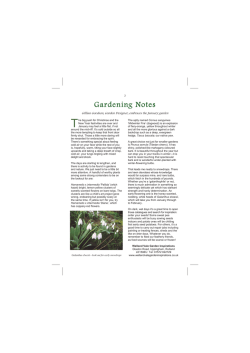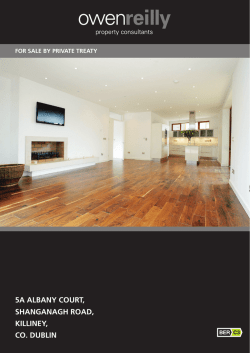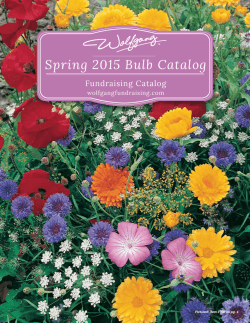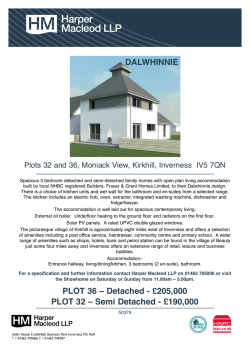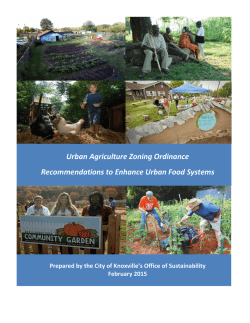
Download the flyer - Arboricultural Association
AA Scottish Branch 2015 WINTER LECTURES, EXCURSION AND AGM Doune Park - 31st January 2015 Ken Martin Memorial Award Dr. Tom Hall Memorial Award Annual General Meeting Visit to Doune Park Arboricultural Association SCOTTISH BRANCH Tel +44 (0)1242 522152 Fax +44 (0)1242 577766 Email: [email protected] A company registered in England at: The Malthouse, Stroud Green, Standish, Stonehouse, Gloucestershire GL10 3DL, UK. Company number 4070377 AA Scottish Branch 2015 WINTER LECTURES, AWARDS AND AGM To be held in Doune Rural Hall, Doune Programme 09.30 – 10.00 Registration. Tea and coffee. 10.00 – 10.10 Welcome and introduction – Paul Hanson, Scottish Branch Chair. 10.10 – 10.50 Root Protection and Tree Planting Solutions for Development Sites. Roy Partington, Product Manager, Infragreen Ltd. 10.50 - 11.25 Joint presentation from staff at the Royal Botanic Garden Edinburgh, highlighting their work across the globe. ‘The role of the arborist in collecting for conservation, with examples from Japan and Bosnia’ - Tom Christian. ‘An arborist abroad: Recent work in Sri Lanka, with a focus on street trees’ - Will Hinchliffe. 11.25 - 11.45 Looking back at 2014 and what do members want in 2015 and beyond' Karen Martin, CEO, The Arboricultural Association. 11.45 - 12.00 Presentation of the 2014 Ken Martin Memorial Award and the Dr Tom Hall Memorial Literary Prize. 12.00 - 12.30 Annual General Meeting (AA Members only). See separate agenda. 12.30 – 1.30 LUNCH. Courtesy of the AA Scottish Branch. 1.30 – 3.30 Tour of Doune Park Estate and Gardens, courtesy of the owner. A rare opportunity to visit the notable and interesting trees which adorn this historic estate (see brief description appended). 3.30 Conclusion and disperse. Booking: The event is free of charge and all members and non-members are welcome to attend. However, places are limited. Please register your attendance in advance (no later than 26 January) to assist in planning for numbers and catering by contacting Donald Rodger at [email protected] or on 01620 842656. Arboricultural Association (Scottish Branch) Notice of 2014 Annual General Meeting 12 noon, Saturday 31 January, 2015 at Doune Rural Hall, Doune, Stirlingshire AGENDA 1. Apologies for absence. 2. Approval of the 2013 AGM minutes. 3. Matters arising from the 2013 AGM minutes. 4. Officers’ reports. 4.1 Chair 4.2 Secretary 4.3 Treasurer 5. Appointment of Committee. 6. Election of Officers. 6.1 6.2 6.3 6.4 7. Chair Vice Chair Secretary Treasurer Any other competent AGM business. Will Hinchliffe Scottish Branch Secretary All AGM queries or agenda items to: Will Hinchliffe (Branch Secretary) on 07866 479416 or e mail: [email protected] Doune Rural Hall Northlea Doune Perthshire FK16 6DH Doune Park - Gardens & Arboretum The garden and arboretum are situated between the house and the walled garden and extend north along the glen of the Buchany Burn. Reference to the 1st edition OS map shows the area to have been wooded in 1869. A path runs from the north side of the house to the arboretum which was established in the late 19th century on the east- facing slope of the glen. It includes coniferous species, many of which were measured by Alan Mitchell in 1980. In a previous publication of 1974 (A Field Guide to the Trees of Britain & Northern Europe), he had described the specimens of Chamaecyparis lawsoniana and C. nootkatensis as being the largest in Scotland. The footpath continues north to the hollow of the Buchany Burn where the 17th Earl had developed the Japanese Garden between 1910-30. It includes some fine Japanese Acers, Magnolia, Sorbus and a fine cut-leaf beech, Fagus sylvatica Heterophylla, which have been underplanted by species Rhododendron and Azalea. A detailed description of plant material in the understorey is given by Peter Verney in 'The Gardens of Scotland' (c.1970), but many of these have been lost in recent years. From the Japanese Garden, the footpath and burn emerge into an open lawn which was once closely mown. The island shrub beds described by Verney have gone. The summerhouse thought to date from c.1825 stands on the east bank of the Burn which flows out through the 'flat meadow lands' which had been drained and levelled in the 19th century. The burn has been canalised along the west side of the walled garden and the cascades remain along its length, as do stone and timber bridges across it. The area on either side of the Burn was overgrown by 1968 and was subsequently cleared to expose the walled garden. Flowering shrubs were planted along the outer walls of the garden and daffodils were established across the lawns. The walled garden is thought to date from the 1820s. Its original layout is thought to have been divided into four regular compartments by intersecting paths, as indicated on the 1st edition OS map of 1869. The garden was ploughed during World War II and was used subsequently as a tree nursery. In 1968 the gardens were restored with the aim of creating a garden with interest at all times of the year which would attract the public. The original structure was kept but only the north-east compartment retained the traditional use of fruit and vegetable cultivation for the house; the north- west area was a Rose Garden, whilst the south- west area was a shrub garden and the south-east area an autumn garden. Double herbaceous borders ran down the west/east axis, whilst double annual borders lined the north/south axis; both were centred on a Sundial which was moved to the garden from its former site in front of the house. The Sundial remains, as do the hedges which divided the compartments.
© Copyright 2025
